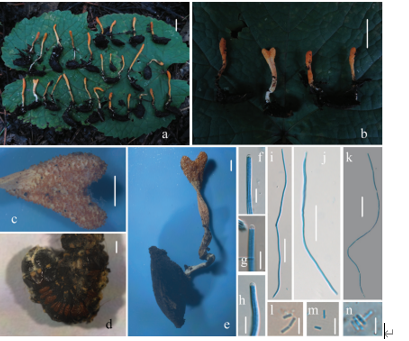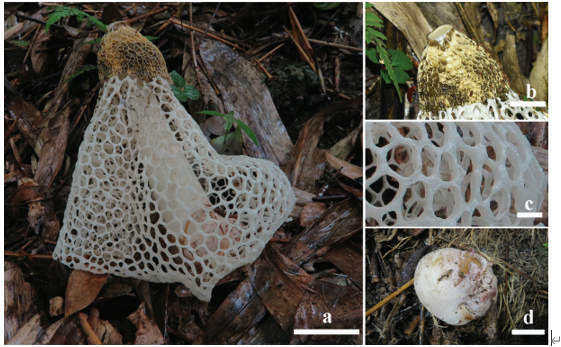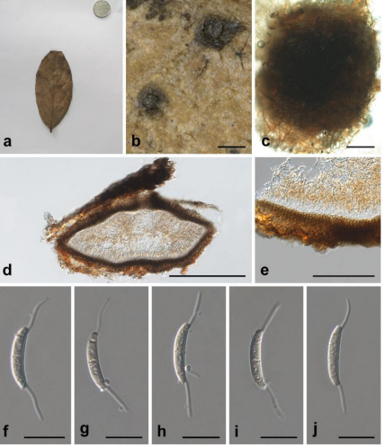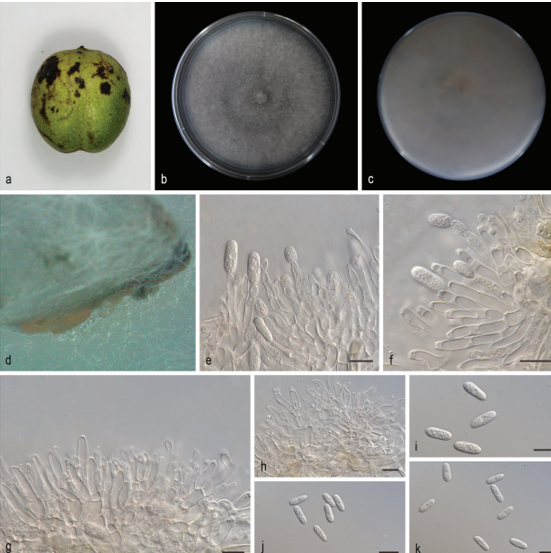Melampsora salicis-michelsonii C. M. Tian & L. L. Wang 2020
MycoBank MB 834617
Holotype: CHINA. Xinjiang Uygur Autonomous Region: Altay Prefecture, Jimuai County, II, III on Salix michelsonii Goerz ex Nasarow, 6 August 2013, coll. L.L. Wang, Y, Yu & H. Wang (Holotype: HMAAC4039).
Morphological description
Spermogonia and aecia unknown. Uredinia amphigenous to mainly hypophyllous, yellow, grouped, 0.1–0.8 mm (Figs. 2A, 2B, 2C). Urediniospores globoid to ellipsoid, 15–22 × 13–17 μm, wall 1.8–2.5 μm thick (Fig. 2D), echinulate spines 1.47–1.91 μm apart (Fig. 2I), 3–6 germ pores, scattered (Fig. 2E). Paraphyses capitate, clavate occasionally, intermixed with urediniospores (Fig. 2H), 37–77 × 11–22 μm, with thickened apical wall up to 6.5 μm sometimes (Fig. 2F). Telia amphigenous to mainly epiphyllous, 0.1–0.4 mm, scattered or aggregated, reddish brown. Subepidermal teliospores 29–46 × 8–16 μm, with evenly thickened wall 1 μm (Fig. 2G).
Habitat: On Salix michelsonii Goerz ex Nasarow.
Distribution: In China.
GenBank Accession: ITS: MK277293; LSU: MK277298
Notes: The habitat was special and the specimens were collected in an arid and less rainy desert areas. The host plant, S. michelsonii, is a kind of psammophyte shrub, which has not been reported to be infected by any rust fungus previously. Melampsora salicis-michelsonii was distinguishable on the basis of phylogenetic analysis (Fig. 1) and morphological characteristics (Table 2). Phylogenetically, it was distinct from other Melampsora species in clustering in a well-supported clade (Fig. 1), and morphologically, different from its close species, M. arctica, M. iranica, M. ribesii-purpureae and M. salicis-purpureae in paraphyses, teliospores and the colonized position of uredinia and telia. The host plant, S. michelsonii is new for the genus Melampsora.
Reference: LI-LI WANG1, 2, KE-MEI LI2, YUN LIU1 et al.

Morphology of Melampsora salicis-michelsonii (HMAAC4039, holotype). A: Habit of sori on leaves. B: Telia (T) and Uredinia (U) on the epiphyllous surface. C: Telia (T) and Uredinia (U) on the hypophyllous surface. D: Globoid and ellipsoid urediniospores observed by LM. E: Scattered germ pores on the urediniospores (red arrows). F: Capitate paraphyses with evenly thickened apex. G: Subepidermal teliospores without thickened apical wall. H: Uredinia observed by SEM, abundant intermixed paraphyses. I: Urediniospores with echinulate spines observed by SEM. Bars: B, C = 1 mm; D−G = 10 μm; H = 20 μm; I = 5 μm.









